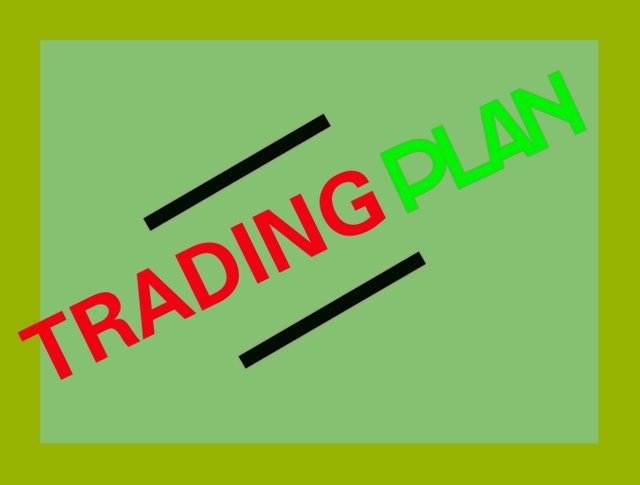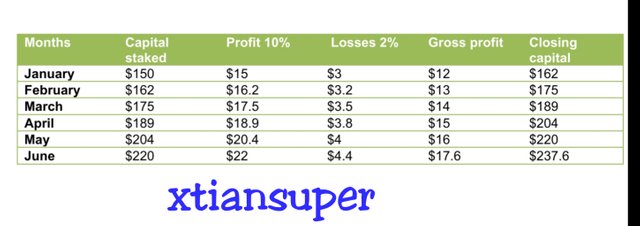Capital Management and Trading Plan - Crypto Academy / S4W8 - Homework post for @ lenonmc21
 cover photo made in photoeditor
cover photo made in photoeditor
Introduction
Planning is very important. It is the basis of every activity. In every profession, people that want to succeed always take time to plan for the future. Both students, business owners and government workers do plan ahead. This is how important planning is. In trading, planning is very crucial. This is because the risk involved especially in cryptocurrency trading is not something that should be overlooked. In order to manage this risk effectively, a trading plan must be developed by traders and judiciously followed. This will help manage our capital and also facilitate a seamless trade.
1. Define and Explain in detail in your own words, what is a "Trading Plan"?
 Image from photoeditor
Image from photoeditor
A trading plan is an outline that shows the assets to be traded as well as the time ad risk of the trade. It outlines systematically the objectives of the trader, the conditions for buy and sell, the capital, the percentage of the capital that a trader is willing to risk, etc. This trading plan also guide traders in taking trading steps. Before any trade is executed, it is expected that traders take their time to draft out a plan, which they will follow in order to minimize losses and maximize profits. With this, a trading plan should be penned down and visited before each trade. The capital staked should be a reasonable amount that can be risked.
The cryptocurrency market is very volatile. It would be wise of traders not to just jump in without proper analysis. The market is unpredictable. This is why it is important to plan before trading. Once there is planning, there will be success.
A trading plan places some restrictions on trade. For instance, trading may stop if things are not working well. It could be a rule that calls off trading if a trader loses two or three trades in a row. It may also be an amount of profit that when reached, a trader will stop trading for the day.
The most important part of trading plan is risk management and capital management. Risk management will allow a trader to set a limit to whatever action he is taking in order not to lose more. A trader may choose to reduce his trading position if the market is not favorable, or increase the trading position if it is going well. All of these precautionary measures, when written down and strictly followed, constitute what is called a trading plan.
2. Explain in your own words why it is essential in this profession to have a "Trading Plan"?
The amount of risk involved in cryptocurrency trading outgrows that of every other trading activity. The cryptocurrency market is one that can be profitable if properly analysed, and can also be damaging if proper care is not taken. This is why it is not wise to start a trade without properly writing down a plan. As discussed in question one above, it can be drawn that there are many reasons why planning a trade is important.
First, a trading plan helps a trader to properly manage his capital. Capital management is really important. If you decide to risk all your money, it may not go well. But taking out a certain percentage of your capital is reasonable. This is why we need a trading plan.
Also, trading plan helps a trader to manage risk. Risk management is in different perspectives. But generally, risk management are those rules that will make a trader to exit the market. It could be due to profits or losses. A certain amount of profit will be enough for the day as prescribed by the plan.
In the same direction, if a trader loose a number of trades or a percentage of the capital, the plan might tell the trader to exit the market so that the worst would not happen. Other reasons why a trading plan is important is that it gives traders direction. It serves as a roadmap and also keep traders on track.
3. Explain and define in detail each of the fundamental elements of a "Trading Plan"
1. Risk Management:
In every trading position we take, it's either we win or lose. Because we really don't know which of this will happen, we have to take precautions to avoid huge losses. Risk management include a set of rules that must be followed to reduce losses. It is only a greedy trader that will want to exceed the number of trades he was supposed to enter for the day.
A trader who has a risk management plan will exit the market once the target is reached, even though he has won all trades for that day. Risk management sets a number of trades to be won, and a number of trades to be lost for the trader to quit the market. If the said trades are won, the trader has to stick to the plan and exit the market no matter how attractive the market may look. If the prescribed losses are made, the trader also must follow the rules and exit the market. You never can tell the next thing that will happen if you try to continue.
For instance, a trader can decide to take a profit of $15 or a loss of $8 for the day. If the very first trade he enters into produces a profit of $15, he is done for the day according to the plan. If he also bears a loss of $8 even if it is at first entry, he is also done for the day.
2. Capital Management:
Capital management is an item in the trading plan that defines the percentage of our capital we want to trade with. It is not wise to start a trade with all of our capital. What if something bad happens? Capital management gives a stipulated amount that we want to trade with. It is always better to trade with an amount you can willingly let go.
For each trading position, there is a certain amount we would love to trade with, Not everything. To properly manage our capital, we have to clearly define the percentage of our total capital that would be risked. We also have to write out the percentage of the capital that will constitute total losses ad total profit. It is also reasonable to select our trading days. This will help us save our money some of the days.
The percentage profit and percentage losses are like two sides of a coin in capital management. Remember, if all capital is lost, there will be nothing left to trade with.
3. Trading Psychology:
Trading Psychology has to do with the personal rules set by a trader. It is mostly what works for him or her. Trading psychology is a disciplinary action taken by the trader to ensure that he follows the rules. Sometimes, traders can be tempted to do more than what is in the plan. Most times, they often feel like taking a revenge on the market. But once you have your personal guidelines, all of those would be avoided. A trading psychology may look like the following;
- Do not trade when you're angry.
- Never try to take a revenge on the market.
- Trade without distractions.
- Keep your emotions aside.
- Only trade 4 to 5 days in a week.
- If you feel reluctant about a trade, don't take it.
- Do a technical analysis before taking a trade.
- Trading only have two possible outcomes; profit or losses.
There are several other rules that will help you stick to the trading plan.
Trading account Planning and Control:
This has to do with the measures we will take to increase our capital as we advance in trading. It is basic that we trade for profit. As our profit increase, we also have to add it to our capital. It is very important to keep records of all trading activities. The profits made each month and losses incurred should all be taken note of. This will help in the proper management of our capital and risk, and also serve as reference point for future trades. Also, as our profits grow, our capital must also grow. Growth is inevitable for every successful traders.
4. Build a “Trading Plan” and cover all the basic elements discussed in the class. For this, you should NOT take the examples that I put in my class (Including the example amounts), use your own examples and own images to make said plan, you must also base this "Trading Plan" as if you were operating on the platform of " Binance ”, taking into account that the minimum amount of exchange or investment is $ 10.
 my trading plan built on Ms word
my trading plan built on Ms word
The trading plan is for a 6 month period. That is, January to June. The months are listed on the first column. For each month, the amount of capital staked is shown as well as the profit and loss percentage. There is also the gross profit and closing capital. Each closing capital becomes the opening capital for the next month. This means that as I'm making profits, my capital is also growing.
The start-up capital was $150 but with time, it grew to $220 in the sixth month. In the third column, I expect a monthly profit of 10% of my capital. I also expect not more than 2% of my capital as losses because that is what I can afford. If I lose 2% capital, trading ends for the month. The gross profit and closing capital are also seen in column 5 and 6 respectively.
My Capital management:
My Risk management:
My Trading Psychology:
- I don't trade when I'm angry, I may end up making a huge mistake.
- I don't try to revenge the market for the losses I made previously.
- If I feel reluctant about a trading position, it is better to stay out of it.
- I trade only in the morning hours. I don't like trading on Mondays. So I do what works best for me.
- I don't trade because I'm persuaded to. What works for others might not work for me.
- Finally, my trading plan is always handy. I work hand in hand with it and follow its prescriptions.
Conclusion
Capital management is really important in cryptocurrency trading. This is why it is necessary to have a trading plan that will serve as guidelines for every trader. Each trading plan should have the basic and fundamental elements which are; capital management, risk management, trading psychology, planning and control. A trading record should also be kept so that each time we're lost, we can always refer to them. This was indeed a great lesson. Much appreciation to professor @lenonmc21 for this one.
Thank you for having me!